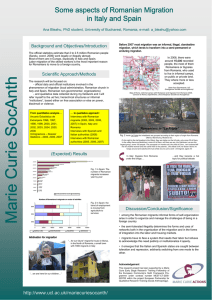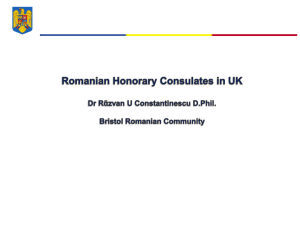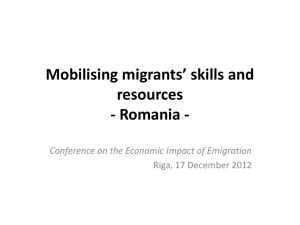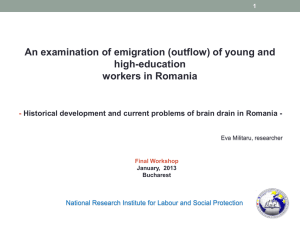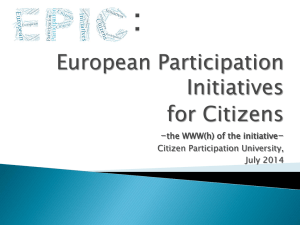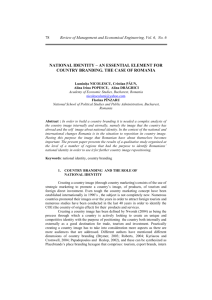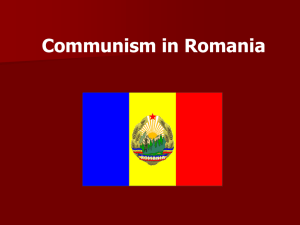Romanians and the UK
advertisement
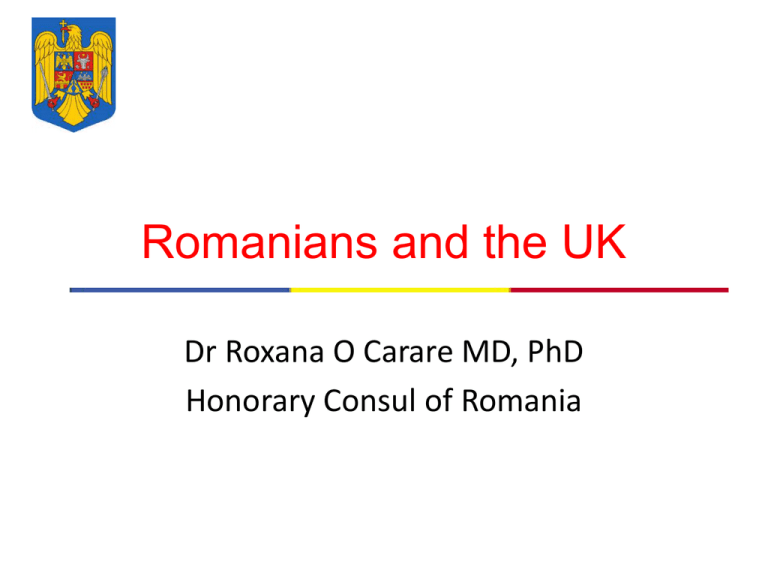
Romanians and the UK Dr Roxana O Carare MD, PhD Honorary Consul of Romania The parallel between 2004 and 2014 misses some important differences in the situations 1. Romanians and Bulgarians have had open access to the UK, if not its labour markets, for six years already, so many of those who would be interested in travelling to and living in the UK have already come. In 2004, borders and labour markets were opened at the same time. 2. In 2004 only three EU nations – the UK, the Republic of Ireland and Sweden – opened their labour markets to A8 workers without restrictions. This made Britain, with its large economy and flexible labour market, a leading destination. In 2014 the entire EU will be obliged to open labour markets to Romanian and Bulgarian workers, so countries like Germany and France may prove very attractive too. 3. The combined populations of Romania and Bulgaria is around 29 million, whereas the combined populations of the A8 countries is around 70 million, meaning there is considerably less potential supply. 4. Romanian and Bulgarians who have emigrated to the EU up to this point have not been especially likely to choose the UK. The majority of Romanian-born emigrants in Europe are concentrated in just two countries: Spain and Italy. http://www.guardian.co.uk/commentisfree/2013/jan/15/bulgarian-romanian-migrationuk-restrictions Demographics estimates from Office of National Statistics • • • • • 2000 doctors 2000 nurses 5000 students 60,000 in London 3000-5000 Birmingham, Manchester, Liverpool, Leeds, Glasgow, Belfast http://www.ons.gov.uk/ons/rel/migration1/population-by-country-of-birthand-nationality/2012/population-by-country-of-birth-and-nationalityreport.html Working force The data published by the Office for National Statistics refer to the number of Romanian citizens in employment, in the United Kingdom, from April to June 2013, and not to „the number of Romanian workers who arrived in the UK April to June 2013”. These data confirm that Romanian workers chose this country as a destination for the economic opportunities offered, and not for accessing the social benefits system. National Insurance numbers National Insurance Across all DWP working age benefits, 31% of those claimants who were non-UK nationals at the time they first registered for a NINo were from within the European Union. Of the remainder, Asia and Middle East (32%) and Africa (24%) form the largest proportion of those claimants who were non-UK nationals at the time of first NINo registration Romania is not in top 20 nationalities ONS, August 2013 Department for Work and Pensions research in welfare (January 2012) showed that, despite the rhetoric of "benefit tourists", those born abroad were significantly less likely to claim benefits than UK nationals. Of the 5.5 million people claiming working age benefits in February 2011, just 371,000 (6.4 per cent) were foreign nationals when they first arrived in the UK. That means only 6.6 per cent of those born abroad were receiving benefits, compared to 16.6 per cent of UK nationals. The Office of Budget Responsibility’Fiscal Sustainability Report (July 2013): -immigration is needed to cope with the challenge of an ageing population and the resultant increase in the national debt. Should Britain maintain net migration of around 140,000 a year (a level significantly higher than the government's target of 'tens of thousands'), debt will rise to 99% of GDP by 2062-63. But should it reduce net migration to zero, debt will surge to174% "[There is] clear evidence that, since migrants tend to be more concentrated in the working-age group relatively to the rest of the population, immigration has a positive effect on the public sector’s debt…higher levels of net inward migration are projected to reduce public sector net debt as a share of GDP over the long term relative to the levels it would otherwise reach." Centre for Economics and Business Research (CEBR) study “The impact of the European Union on the UK labour market” (August 2013) : EU migrants account for a growing proportion of total employment in the UK; Census data for 2011 show that non-UK-born EU citizens are less likely to be unemployed or economically inactive than their UK-born counterparts; EU migrants appear to be addressing skills shortages in both professional and more elementary occupations; Economic growth is higher under scenarios with more net migration than scenarios with lower net migration; Migration Matters Trust report (august 2013) as a response to the claim that “a net 50,000-300,000 new migrants will arrive in the UK from Romania and Bulgaria each year” showed that: Destination of emigration - currently 96% of Romanian migrants to EU countries choose destinations other than the UK. Italy and Spain have 10 times the numbers of Romanian migrants (888,000 and 823,000 respectively) while Germany has 160,000 Romanian migrants (source: Eurostat) The data on employment rate from the Labour Force Survey (LFS) has highlighted how the number of Romanians and Bulgarians in employment in the UK has risen by 36% over the past year from 104,000 in Q2 2012 to 141,000 in Q2 2013 (figures releases August 2013). We need to take into account: Small sample size - Only 180 respondents were used to extrapolate these particular figures LFS definition of migrants The LFS will include Romanians and Bulgarians who are here for short term seasonal work of six months or less. The government's net migration figures only include people migrating to Britain for a year or more. This means the LFS will inflate the potential total of migrants, as defined by the government, by including those who are here for short periods. Roma community The latest statistics show that in Romania there are approximately 600,000 Roma people, meaning those citizens who declared their Roma ethnicity at the latest 2011 census, representing 3% of Romania’s population and approximately 5% of the total Roma population in Europe. Romania has adopted a wide package of laws and juridical instruments in order to ensure the necessary instruments for the Romanian authorities to efficiently fight against discrimination of Roma population and protect vulnerable groups. By the Strategy of the Government of Romania for the inclusion of the Romanian citizens belonging to Roma minority for the period 2012-2020, Romania tackles the Roma issue on four main areas: education, health, housing and employment. The most ambitious targets set by the Romanian Government include the access to labour market, measures at sector level for generating income, access to healthcare, reducing school dropout, promoting artistic values, creating civic educational programmes and crime prevention. Where do Romanians migrate? The overwhelming majority of Romanians and Bulgarian migrants currently choose as a destination other EU countries; Denmark, with its high wages and generous welfare state, experienced only a small increase in migration, even though it was the only EU country to relax transitional controls; Unlike 2004, when the UK relaxed transitional controls but most EU states didn’t, every country is making the same change at the same time, including Spain, Italy and Germany which have historically been the preferred destinations for Romanians; The sustainability of the public finances in the long-term is contingent on net migration. Our expectation is that net migration from Romania and Bulgaria to the UK will average 20,000 or less per year over the period 2014-2019. Growth in Romania. Why leave? Romanian Government has in place policies aimed at stimulating growth and strengthening the economy, the unemployment being currently below the EU average and public sector wages have risen Unemployment rate in December 2012 was 6.5%, Romania ranking the 5th position in terms of lowest rates recorded in the EU, after Austria, Germany, Luxembourg and the Netherlands. After the economic crisis and negative growth rates in 2009 and 2010, Romania returned to a steady and sustainable path of economic growth, with 2.5% in 2011, 0.2% in 2012 (only six EU member states had positive growth last year) and a 1.6% GDP increase envisaged for 2013. Romania’s medium term economic prospects are particularly encouraging, with an average annual potential growth of 3-4%. Visit Romania! And…latin sense of humour!! Thank you • Embassy of Romania, UK • His Excellency Dr Ion Jinga • SOS Polonia – Mrs Barbara Storey, Mr Dan Profir
